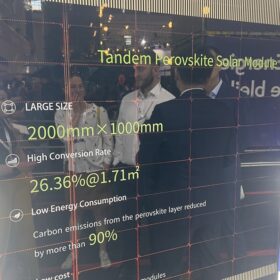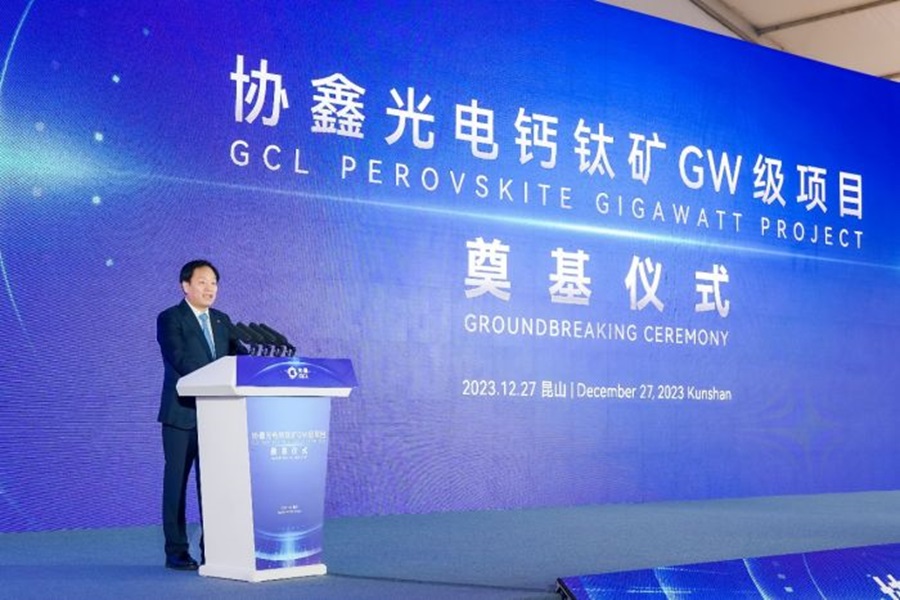From pv magazine Global
Chinese solar module maker CGL Technology presented its latest perovskite solar module technology at the Intersolar tradeshow in Munich, Germany, this week.
“This module has met IEC testing standards that would suggest it would degrade in a pattern that is similar to standard silicon solar modules,” the company’s spokesperson, Martin Wang, told pv magazine, noting that the company expects this perovskite product to be deployed as part of a perovskite-silicon tandem solar module which will begin mass production in late 2025.
Wang also revealed that GCL perovskite modules were used in the 1 MW perovskite solar power project deployed by China Three Gorges in late 2023.
The company said the deployment of their pure perovskite module at the China Three Gorges solar project represented the state-of-field testing stage of the product. The company hopes to deploy multiple 1 MW projects before the end of the year across different geographies with different environmental traits, to test the viability of the perovskite module.

At the booth, GCL showed two perovskite solar modules: one a pure perovskite module, and the other a perovskite silicon tandem solar module. The pure perovskite module has an efficiency of just over 19%, while the tandem module’s efficiency is just over 26%.
Wang explained that the perovskite solar panel had passed TUV Rhineland IEC 61215 and IEC 61739 certification tests, which would suggest that the solar modules would degrade like a standard silicon solar panel. Wang implied that GCL was moving slowly into the market with that statement because the tests are designed to degrade silicon products, and not perovskite products.
GCL has supplied pv magazine with the IEC certification document. Further documentation to better interpret the degradation results has been requested.
The modules came from a 100 MW test line that has been in place since 2021. The majority of the modules from this test line, which totaled 10 to 15 MW in 2023, have been recycled, as the modules progressed toward units they felt were worthy of deployment.
Wang said that GCL believes the degradation of their perovskite silicon tandem module will be better than that of standard silicon modules. Starting at the end of next year, GCL will begin deploying their perovskite silicon tandem solar module.
A key detail on the product that is different from many others in the market is that the tandem aspect of the product is on a module level – not the cell level. What this means to the manufacturer is that “95% of the hard work” will have already been done in the creation of the perovskite module.
Wang also explained that combining two solar panels was a much simpler process than making a tandem solar cell, and that of the hand-crafted perovskite silicon tandem modules, the units work 95% of the time, and that once the manufacturing line is in place this value will reach near 100%.
Wang said that on a cost-per-watt basis – not expected market price – the company expected the perovskite silicon tandem module would cost 50% of a crystalline silicon module that costs $0.15 per W, meaning $0.075 per W. He said the 50% value that was used in marketing on the perovskite silicon module was done when polysilicon was more expensive, and thus modules were more expensive.
When asked by pv magazine about future efficiency gains, Wang said GCL – in this case – is a perovskite company first. “We should realize the full potential of perovskites, and we should adapt silicon to the perovskite – instead of the other way around,” he stated.
By next year, they expect the tandem module to break 27% efficiency – with greater than 30% “guaranteed”. Currently, in the tandem structure, it is the perovskite module that is contributing the majority of the efficiency, as it is generating at 19% – while the silicon is only running at 7% efficiency.
The current silicon base module used is a TOPCon unit, however, GCL believes that heterojunction will be the best long-term solution due to the product’s higher voltage.
This content is protected by copyright and may not be reused. If you want to cooperate with us and would like to reuse some of our content, please contact: editors@pv-magazine.com.








By submitting this form you agree to pv magazine using your data for the purposes of publishing your comment.
Your personal data will only be disclosed or otherwise transmitted to third parties for the purposes of spam filtering or if this is necessary for technical maintenance of the website. Any other transfer to third parties will not take place unless this is justified on the basis of applicable data protection regulations or if pv magazine is legally obliged to do so.
You may revoke this consent at any time with effect for the future, in which case your personal data will be deleted immediately. Otherwise, your data will be deleted if pv magazine has processed your request or the purpose of data storage is fulfilled.
Further information on data privacy can be found in our Data Protection Policy.